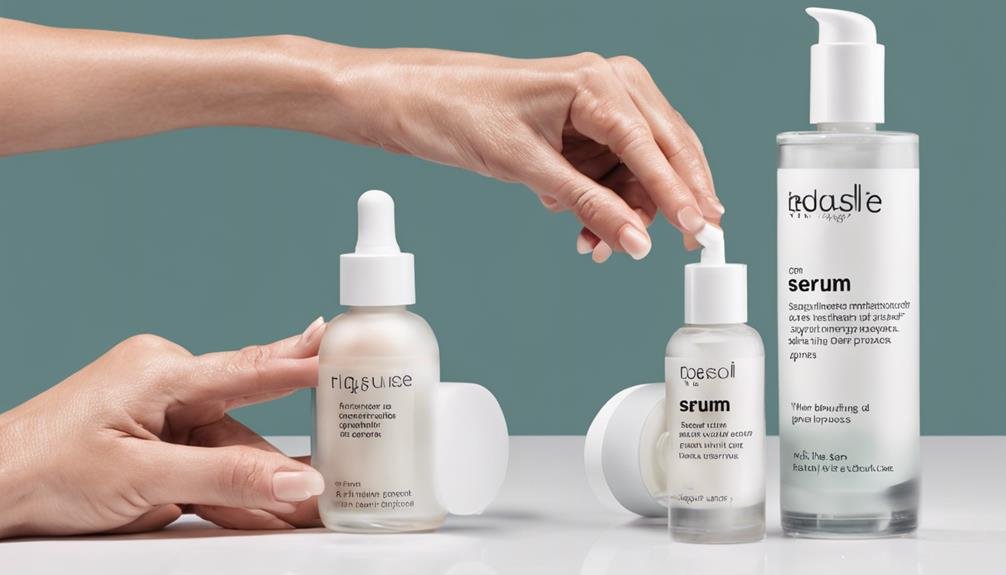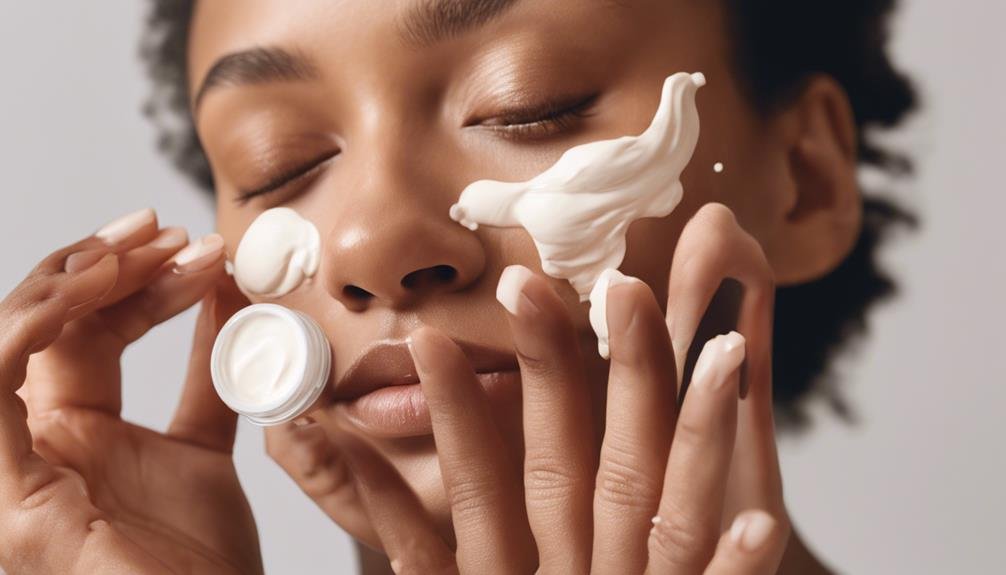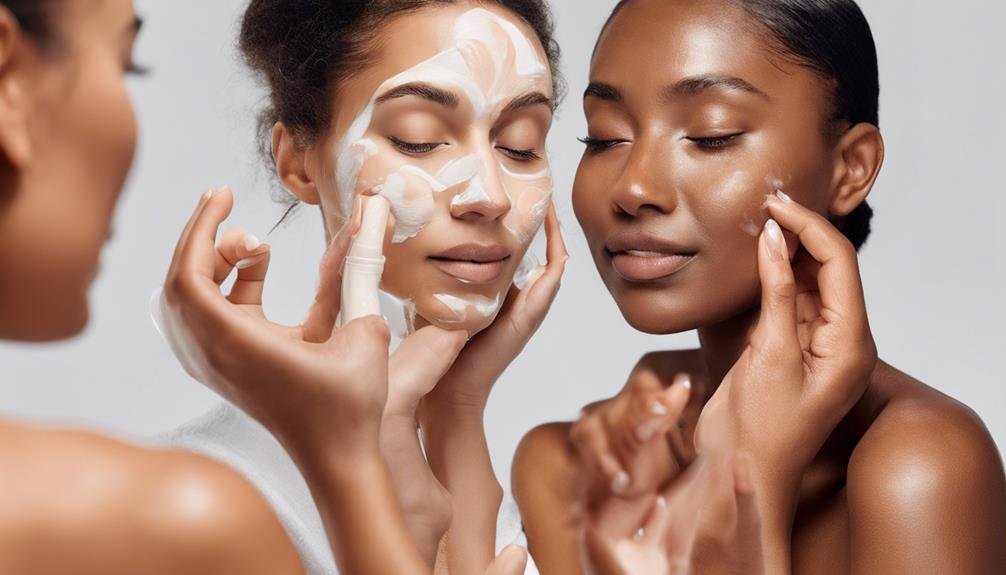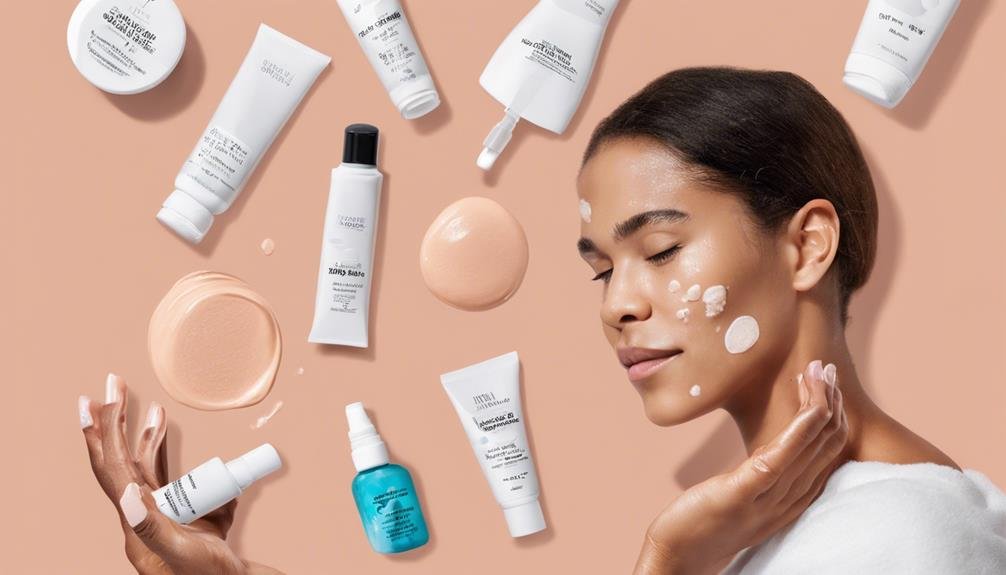When it comes to your skin care routine, layering products correctly can make a significant difference in how your skin looks and feels. By understanding the order in which to apply your products and the importance of allowing each layer to absorb properly, you can enhance the efficacy of your skincare regimen. But, there's one crucial aspect many overlook that can either boost or hinder the results of all your efforts.
Key Takeaways
- Layer products from thinnest to thickest consistency for proper absorption.
- Apply serums after cleansing and toning to target specific skin concerns.
- Use lightweight serums with concentrated active ingredients for effective treatment.
- Follow with moisturizer to lock in moisture and sunscreen for long-term skin protection.
- Consistency in layering and product application is key for optimal results.
Cleansing
When it comes to layering skin care products, the first step you should always start with is cleansing. Cleansing serves as the foundation of any skincare routine by removing impurities, excess oil, and dirt from your skin. It helps to prepare your skin to better absorb the subsequent products in your routine, making them more effective.
When choosing a cleanser, opt for one that matches your skin type – whether it's oily, dry, combination, or sensitive. Look for gentle cleansers with a pH-balanced formula to maintain the natural balance of your skin.
Ensure you cleanse your face both in the morning and at night to maintain a clean canvas for your skin care products. Massage the cleanser onto damp skin using gentle, circular motions, then rinse thoroughly with lukewarm water. Avoid using hot water as it can strip the skin of its natural oils, leading to dryness.
Toning
Having thoroughly cleansed your skin, the next step in your skincare routine is toning. Toning is a crucial step that helps to balance the pH of your skin, remove any remaining impurities, and prepare your skin for better absorption of subsequent products. Using a toner can also help to tighten pores, minimize the appearance of fine lines, and improve overall skin texture.
When choosing a toner, opt for alcohol-free formulas that contain gentle ingredients like witch hazel, rose water, or hyaluronic acid. These ingredients can help soothe and hydrate the skin without causing irritation. To apply the toner, pour a small amount onto a cotton pad and gently swipe it across your face and neck. Avoid harsh rubbing, as this can lead to unnecessary irritation.
Incorporating a toner into your skincare routine can make a noticeable difference in the overall health and appearance of your skin. It sets the foundation for the rest of your products to work more effectively, leaving you with a radiant and balanced complexion.
Serums
For optimal skin nourishment and targeted treatment, incorporating serums into your skincare routine is essential. Serums are lightweight, fast-absorbing liquids packed with potent active ingredients tailored to address specific skin concerns. These concentrated formulas penetrate deeply into the skin, delivering a high concentration of active ingredients such as antioxidants, vitamins, and hyaluronic acid.
When layering serums, start with the thinnest consistency and build up to thicker textures. After cleansing and toning, apply a pea-sized amount of serum onto your fingertips and gently press it into your skin. Allow the serum to absorb fully before applying the next product in your routine.
Serums can target various skin issues like hyperpigmentation, fine lines, dehydration, and dullness. Look for serums with ingredients like vitamin C for brightening, retinol for anti-aging, or niacinamide for minimizing pores.
Remember to always follow up with a moisturizer and sunscreen to seal in the benefits of your serums and protect your skin throughout the day.
Eye Cream
Consistently incorporating an eye cream into your skincare regimen can offer targeted hydration and treatment for the delicate skin around your eyes. The skin around the eyes is thinner and more prone to dryness and fine lines, making it essential to provide specialized care.
Look for eye creams containing ingredients like hyaluronic acid, peptides, and antioxidants to help hydrate, firm, and protect this sensitive area.
When applying eye cream, use your ring finger to gently tap a small amount along the orbital bone, starting from the inner corner of the eye and moving outwards. Avoid applying too close to the lash line to prevent irritation.
Incorporating an eye cream into your routine can help reduce puffiness, dark circles, and crow's feet over time.
Remember to apply eye cream before your moisturizer to allow the skin around your eyes to fully absorb the targeted ingredients. By giving this delicate area the attention it deserves, you can maintain a youthful and radiant appearance.
Moisturizer
To effectively hydrate and protect your skin, incorporating a quality moisturizer into your skincare routine is crucial. Moisturizers help lock in moisture, prevent water loss, and create a barrier against environmental stressors. When choosing a moisturizer, consider your skin type and concerns to select the best formula for your needs. Here is a breakdown of key ingredients to look for in a moisturizer:
| Column 1 | Column 2 | Column 3 |
|---|---|---|
| Hyaluronic Acid | Glycerin | Ceramides |
| Aloe Vera | Vitamin E | Niacinamide |
| Shea Butter | Squalane | Peptides |
| Antioxidants | Retinol | Panthenol |
| Green Tea Extract | Jojoba Oil | Alpha Hydroxy Acids |
These ingredients work synergistically to hydrate, repair, and protect your skin. Remember to apply your moisturizer after serums and treatments to seal in the benefits and keep your skin healthy and glowing.
Sunscreen
To ensure your skin's long-term health and protect it from harmful UV rays, incorporating sunscreen into your daily skincare routine is vital. Sunscreen is a crucial step in protecting your skin from the damaging effects of sun exposure, such as premature aging, sunburn, and an increased risk of skin cancer.
When selecting a sunscreen, opt for a broad-spectrum formula that protects against both UVA and UVB rays with an SPF of 30 or higher. Apply sunscreen as the final step in your morning skincare routine, after moisturizer and before makeup. Be sure to use the appropriate amount, about a nickel-sized dollop for your face, to ensure adequate coverage.
Reapply every two hours, or more frequently if swimming or sweating. Remember that sunscreen isn't just for sunny days; UV rays can penetrate through clouds and windows, so make it a daily habit to protect your skin.
Acids
Acids play a crucial role in skincare by exfoliating the skin, promoting cell turnover, and addressing various skin concerns. Incorporating acids into your skincare routine can help improve the overall texture and appearance of your skin.
Salicylic acid is excellent for acne-prone skin as it penetrates deep into the pores, removing excess oil and dead skin cells.
Glycolic acid, derived from sugarcane, is known for its exfoliating properties, making it effective in reducing the appearance of fine lines and hyperpigmentation.
Lactic acid, a gentle exfoliant, is suitable for sensitive skin types as it helps to hydrate and brighten the skin.
When using acids, it's essential to introduce them gradually into your routine to prevent irritation. Start by using them a few times a week and gradually increase frequency as your skin builds tolerance. Remember to always follow up with sunscreen during the day, as acids can make your skin more sensitive to the sun.
Antioxidants
Antioxidants play a significant role in skincare, particularly in combating the effects of environmental stressors on the skin. These powerful compounds help neutralize free radicals, unstable molecules that can damage skin cells and accelerate aging. Incorporating antioxidants into your skincare routine can help protect your skin from pollution, UV radiation, and other external aggressors.
Vitamin C is a popular antioxidant known for its brightening and protective properties. It can help even out skin tone, reduce inflammation, and boost collagen production.
Another effective antioxidant is Vitamin E, which moisturizes the skin and enhances its natural barrier function.
Green tea extract is rich in antioxidants like catechins, which have anti-inflammatory and anti-aging benefits.
When layering antioxidants in your skincare routine, start with the most potent formulas, like serums or concentrates, before applying heavier creams or oils. This allows the antioxidants to penetrate the skin effectively and provide maximum protection and benefits.
Remember to wear sunscreen during the day to complement the antioxidant protection and keep your skin looking healthy and radiant.
Spot Treatments
When targeting specific skin concerns like acne breakouts or dark spots, spot treatments can be a valuable addition to your skincare routine. These targeted products are formulated with potent ingredients to address particular issues in specific areas of your face.
For acne-prone skin, spot treatments containing ingredients like benzoyl peroxide, salicylic acid, or sulfur can help reduce inflammation and kill acne-causing bacteria. If you're dealing with dark spots or hyperpigmentation, look for spot treatments with ingredients such as vitamin C, niacinamide, or kojic acid to help lighten and brighten those areas.
When incorporating spot treatments into your routine, it's essential to apply them after cleansing and toning but before moisturizing. Use a small amount directly on the affected area or spots, and gently pat it in until fully absorbed. Remember to follow the specific instructions provided with the product to ensure optimal results without causing irritation.
Spot treatments should be used consistently for best outcomes, but if you experience any redness or discomfort, discontinue use and consult a dermatologist.
Face Oils
Face oils are versatile skincare products that can provide nourishment, hydration, and a healthy glow to your skin. They're rich in antioxidants and essential fatty acids, making them beneficial for various skin types.
When layering face oils in your skincare routine, consider the following:
- Choose the Right Oil: Opt for oils that suit your skin type, such as jojoba oil for oily skin or rosehip oil for dry skin.
- Apply After Water-Based Products: Face oils should be applied after water-based serums to seal in moisture and enhance absorption.
- Use Sparingly: A little goes a long way with face oils. Start with a few drops and adjust according to your skin's needs.
- Seal in Moisture: Face oils create a protective barrier on the skin, locking in moisture and preventing water loss.
Incorporating face oils into your skincare routine can boost hydration and nourishment, leaving your skin looking radiant and healthy.
Face Masks
Regularly incorporating face masks into your skincare routine can provide a targeted and intensive treatment for various skin concerns. Face masks come in different formulations such as clay, sheet masks, gel masks, and cream masks, each designed to address specific skin issues.
Clay masks are excellent for purifying and detoxifying oily skin, while sheet masks provide deep hydration and nourishment. Gel masks are ideal for soothing and calming sensitive skin, and cream masks offer intense moisture for dry skin types.
When applying a face mask, ensure your skin is clean and exfoliated to maximize absorption. Leave the mask on for the recommended time, usually 10-20 minutes, and then gently massage any remaining product into your skin or rinse off with lukewarm water.
Use face masks 1-2 times per week, depending on your skin's needs, to maintain a healthy and radiant complexion.
Final Tips
To achieve optimal results in layering skin care products, it's crucial to consider a few final tips that can enhance the effectiveness of your routine.
- Consistency is Key: Establishing a consistent skincare routine is essential for seeing long-term results. Stick to your regimen to allow the products to work synergistically and deliver the best outcomes.
- Patience Pays Off: Give your skin time to adjust to new products. It can take a few weeks for your skin to adapt, so be patient and allow the products to demonstrate their full potential.
- Sunscreen Is Non-Negotiable: Always finish off your morning skincare routine with a broad-spectrum sunscreen to protect your skin from harmful UV rays and prevent premature aging.
- Listen to Your Skin: Pay attention to how your skin reacts to different products. If you notice any irritation or redness, adjust your routine accordingly to avoid potential damage.
Frequently Asked Questions
Can I Use Skin Care Products From Different Brands Together?
Yes, you can use skin care products from different brands together. However, be cautious of potential interactions between ingredients. Patch testing and gradually introducing new products can help prevent adverse reactions and optimize results.
How Long Should I Wait Between Applying Each Product?
Between applying each product, wait 30 seconds to 1 minute. This allows optimal absorption and prevents product pilling. Think of it as giving each layer a chance to settle before adding another, ensuring each step's effectiveness.
Is It Necessary to Layer Products in a Specific Order?
Yes, it's essential to layer skin care products in a specific order for optimal results. This ensures ingredients penetrate effectively. Typically, start with lighter consistencies and move to heavier ones. Following this sequence maximizes the benefits of each product.
Can I Mix Different Types of Serums Together?
Yes, you can mix different types of serums together, but it's essential to ensure compatibility. Check ingredients to avoid potential reactions. Patch test before full-face application. Proceed cautiously to prevent adverse skin reactions.
Should I Adjust My Skincare Routine Based on the Season?
Adjust your skincare routine based on the season for optimal results. In colder months, focus on hydration and protection. In warmer months, lightweight products with SPF are key. Consult with a dermatologist for personalized advice.
Conclusion
Now that you know how to properly layer your skin care products, experiment with different combinations to see what works best for your skin. Remember, consistency is key when it comes to achieving healthy, glowing skin. So, stick to your routine and give your products time to work their magic. Don't be afraid to switch things up if you're not seeing the desired results. Keep exploring and refining your skincare routine for optimal results.







